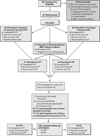Long-term outcomes of cognitive-behavioral treatments for posttraumatic stress disorder among female rape survivors
- PMID: 22182261
- PMCID: PMC3336190
- DOI: 10.1037/a0026602
Long-term outcomes of cognitive-behavioral treatments for posttraumatic stress disorder among female rape survivors
Abstract
Objective: We conducted a long-term follow-up (LTFU) assessment of participants from a randomized controlled trial comparing cognitive processing therapy (CPT) with prolonged exposure (PE) for posttraumatic stress disorder (PTSD). Competing hypotheses for positive outcomes (i.e., additional therapy, medication) were examined.
Method: Intention-to-treat (ITT) participants were assessed 5-10 years after participating in the study (M = 6.15, SD = 1.22). We attempted to locate the 171 original participants, women with PTSD who had experienced at least one rape. Of 144 participants located, 87.5% were reassessed (N = 126), which constituted 73.7% of the original ITT sample. Self-reported PTSD symptoms were the primary outcome. Clinician-rated PTSD symptoms, comorbid diagnoses, and self-reported depression were secondary outcomes.
Results: Substantial decreases in symptoms due to treatment (as reported in Resick, Nishith, Weaver, Astin, & Feuer, 2002) were maintained throughout the LTFU period, as evidenced by little change over time from posttreatment through follow-up (effect sizes ranging from pr = .03 to .14). No significant differences emerged during the LTFU between the treatment conditions (Cohen's d = 0.06-0.29). The ITT examination of diagnostics indicated that 22.2% of CPT and 17.5% of PE participants met the diagnosis for PTSD according to the Clinician-Administered PTSD Scale (Blake et al., 1995) at the LTFU. Maintenance of improvements could not be attributed to further therapy or medications.
Conclusions: CPT and PE resulted in lasting changes in PTSD and related symptoms over an extended period of time for female rape victims with extensive histories of trauma.
PsycINFO Database Record (c) 2012 APA, all rights reserved.
Figures
Comment in
-
Cognitive behavioural treatments have long-term benefits in female rape survivors with post-traumatic stress disorder.Evid Based Ment Health. 2012 Nov;15(4):89. doi: 10.1136/ebmental-2012-100764. Epub 2012 Aug 3. Evid Based Ment Health. 2012. PMID: 22864464 No abstract available.
Similar articles
-
Resolution of trauma-related guilt following treatment of PTSD in female rape victims: a result of cognitive processing therapy targeting comorbid depression?J Affect Disord. 2005 Jun;86(2-3):259-65. doi: 10.1016/j.jad.2005.02.013. J Affect Disord. 2005. PMID: 15935245 Free PMC article. Clinical Trial.
-
Rape survivors' trauma-related beliefs before and after Cognitive processing therapy: associations with PTSD and depression symptoms.Behav Res Ther. 2015 Mar;66:49-55. doi: 10.1016/j.brat.2015.01.002. Epub 2015 Jan 29. Behav Res Ther. 2015. PMID: 25698164 Clinical Trial.
-
Change in sleep symptoms across Cognitive Processing Therapy and Prolonged Exposure: a longitudinal perspective.Behav Res Ther. 2013 Dec;51(12):817-22. doi: 10.1016/j.brat.2013.09.008. Epub 2013 Oct 7. Behav Res Ther. 2013. PMID: 24184428 Free PMC article. Clinical Trial.
-
Psychosocial interventions for survivors of rape and sexual assault experienced during adulthood.Cochrane Database Syst Rev. 2023 Oct 5;10(10):CD013456. doi: 10.1002/14651858.CD013456.pub2. Cochrane Database Syst Rev. 2023. PMID: 37795783 Free PMC article. Review.
-
A meta-analytic review of cognitive processing therapy for adults with posttraumatic stress disorder.Cogn Behav Ther. 2019 Jan;48(1):1-14. doi: 10.1080/16506073.2018.1522371. Epub 2018 Oct 18. Cogn Behav Ther. 2019. PMID: 30332919 Review.
Cited by
-
Sexual assault-characteristics effects on PTSD and psychosocial mediators: a cluster-analysis approach to sexual assault types.Psychol Trauma. 2015 Mar;7(2):162-70. doi: 10.1037/a0037304. Epub 2014 Aug 18. Psychol Trauma. 2015. PMID: 25793692 Free PMC article.
-
Using Prolonged Exposure and Cognitive Processing Therapy to Treat Veterans with Moral Injury-Based PTSD: Two Case Examples.Cogn Behav Pract. 2018 Aug;25(3):377-390. doi: 10.1016/j.cbpra.2017.09.003. Epub 2017 Oct 13. Cogn Behav Pract. 2018. PMID: 30147290 Free PMC article.
-
Maintenance of intervention effects: long-term outcomes for participants in a group talk-therapy trial in the Democratic Republic of Congo.Glob Ment Health (Camb). 2022 Jul 26;9:347-354. doi: 10.1017/gmh.2022.39. eCollection 2022. Glob Ment Health (Camb). 2022. PMID: 36618721 Free PMC article.
-
Examining the associations between PTSD symptoms and aspects of emotion dysregulation through network analysis.J Anxiety Disord. 2022 Mar;86:102536. doi: 10.1016/j.janxdis.2022.102536. Epub 2022 Jan 31. J Anxiety Disord. 2022. PMID: 35121479 Free PMC article.
-
Canadian clinical practice guidelines for the management of anxiety, posttraumatic stress and obsessive-compulsive disorders.BMC Psychiatry. 2014;14 Suppl 1(Suppl 1):S1. doi: 10.1186/1471-244X-14-S1-S1. Epub 2014 Jul 2. BMC Psychiatry. 2014. PMID: 25081580 Free PMC article. Review.
References
-
- American Psychiatric Association. Diagnostic and statistical manual of mental disorders. 4th ed. Washington, DC: Author; 1994.
-
- Aziz MA, Kenford S. Comparability of telephone and face-to-face interviews in assessing patients with posttraumatic stress disorder. Journal of Psychiatric Practice. 2004;10:307–313. - PubMed
-
- Beck AT, Steer RA, Garbin MG. Psychometric properties of the Beck Depression Inventory: Twenty-five years of evaluation. Clinical Psychology Review. 1988;8:77–100.
-
- Beck AT, Ward CH, Mendelson M, Mock J, Erbaugh J. An inventory for measuring depression. Archives of General Psychiatry. 1961;4:561–571. - PubMed
-
- Blake DD, Weathers FW, Nagy LM, Kaloupek DG, Gusman FD, Charney DS, Keane TM. The development of a clinician-administered PTSD scale. Journal of Traumatic Stress. 1995;8:75–90. - PubMed
Publication types
MeSH terms
Grants and funding
LinkOut - more resources
Full Text Sources
Medical
Research Materials
Miscellaneous


